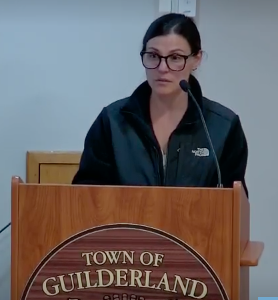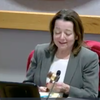Willow Street activist challenges the town to fix speeding traffic
— Still frame from Oct. 15, 2024 Guilderland Town Board meeting
“Traffic has evolved from vehicles of residents,” Alexandra Mitsios tells the Guilderland Town Board, “to a major increase of large trucks for delivery — for example, UPS, FedEx, and Amazon, not to mention the epidemic of distracted driving.”
GUILDERLAND — Willow Street residents continue to seek a permanent fix for the speeding traffic on their residential road.
“I want to make sure that the message for many concerned neighbors on and along Willow Street is heard by all, especially by those who are to ultimately determine if the future proposals and recommendations of the Traffic Safety Committee will come to fruition or will ultimately be ignored,” Alexandra Mitsios told the Guilderland Town Board on Oct. 15.
Mitsios, who lives at 11 Willow St., had addressed the board on the same topic in August.
“I don’t know what the cause is, but we’re finding the same issue all throughout the town,” said Supervisor Peter Barber after Mitsios had concluded her remarks. “I don’t know if it was the pandemic, people’s stress, I don’t know what it is, but we’re getting a lot more aggressive driving, distracted driving, and whatnot.”
He said that “any place that’s connected to a traffic light, people seem to be more aggressive. They want to get that light.”
There is a traffic light at the head of Willow Street where it meets Guilderland’s major thoroughfare, Route 20, near an old schoolhouse that now serves as a station for State Troopers. At the foot of the road is a trailhead for the Pine Bush Preserve.
In between is a bending, once rural road, with no shoulders or sidewalks now traversed by roads leading to residential developments.
Mitsios updated the board on the Oct. 8 meeting of the Traffic Safety Committee during which its chairman, Sergeant Todd Roberts, presented findings of a traffic study on Willow Street, conducted from mid-August to September.
Over 500 vehicles travel daily on Willow, which Mitsios termed “quite a surprise” as residents had estimated around 300.
“The average speed hovered above the 30-mile-an-hour speed limit in the mid-thirties,” she said. Speeds increased for northbound drivers in the afternoon and evening, presumably from residents heading home.
“Much of the speeding that occurs is on the straightaway from the corner of Siver [Road] to the back neighborhood of Pine View Drive,” Mitsios said.
The study’s highest recorded speed was 50 miles per hour, she said.
“Traffic has evolved from vehicles of residents,” Mitsios said, “to a major increase of large trucks for delivery — for example, UPS, FedEx, and Amazon, not to mention the epidemic of distracted driving.”
She told the board, “A significant number of young families have moved to the area seeking safe and walkable neighborhoods. With that comes a significant increase in the number of children. And I cannot describe the frustration that I feel as a parent, the risk this street causes.
“I cannot underscore how mortally dangerous it is for walkers, runners, bike riders, and dog walkers alike.”
A few neighbors declined to sign her petition, Mitsios said, not because they didn’t want to calm traffic but rather because “they had been part of so many [requests] in the past … Because no action was taken, they felt it was sort of null and void, that their voices were not being heard and they felt defeated.”
She named several residents and their fears of Willow Street traffic. A 74-year resident said she was afraid to get her newspaper in the morning. Another resident said “he’s had near-misses on his front lawn” while children were on the lawn.
Residents who have lived on Willow for half of a century “feel like this has been an increasingly large problem,” said Mitsios.
She challenged the board, “We now turn to the town of Guilderland to follow through on promises to constituents with a permanent solution to a problem that has spanned decades before there is a tragic outcome.”
Response
Barber responded, as he had in August, that speed humps in McKownville “to my pleasant surprise … actually seemed to have worked.”
He had said in August that it is best to install the humps when a street is being repaved; Willow was last paved in 2013.
On Oct. 15, Barber said, “I think nowadays the construction of speed humps is not so dependent upon the repaving of a road … The highway guys are pretty talented. They can make the road work.”
Speed humps can also make snow removal difficult, said Barber, adding, “But I think we can do it.”
Two or three speed humps would be needed, Barber said, and each would be about 20 feet in length.
“So you’ve got to find those sections where you’re not interfering with a fire hydrant, a driveway, or even mailboxes.” said Barber.
He continued, “That’s something the highway department is looking into right now, not only your roads but other roads, just to see.”
Mitsios termed that “wonderful to hear.”
She said, too, she had corresponded with Deputy Supervisor Christine Napierski, who serves on the Traffic Safety Committee along with Councilwoman Amanda Beedle.
One idea in this exchange, she said, was, since Willow currently has no shoulders, that, when it is repaved, a bike path could be added, which wouldn’t solve the speeding problem but would provide a buffer.
Barber said that, if he lived on Willow Street, he would be frustrated because “all those cars that are passing or flying down are usually people who live in the neighborhood.”
“It’s not about pointing fingers …,” responded Mitsios. “We’re all guilty of that at some point or another, right?”
She went on to suggest that the speed humps could be marked as crosswalks, as other towns have done.
Councilman Jacob Crawford said the city of Albany had done so. “When they put them in, they put them at intersections and did kind of stripe them,” he said.
“There’s a highway manual that we have to follow, based on the classification of the road,” said Berber.
“I think we should invest some time in coming up with some kind of guidelines or policies …,” said Napierski. “We don’t want to rule anything out at this point. I think we need to look at all the options, including, when we pave the road, you know, installing a shoulder.”
Sewer district
On Oct. 15, the board held two state-required public hearings on the sewer district assessment roll. No one spoke at either hearing.
The first hearing was on principal and interest expenses.
“In Zone A, which is where there are already sewers,” said Barber, “the rate actually would decrease by two cents and, in the area of Zone B, where there’s likely to be sewers proposed in the near future, the increase [would be] three pennies from last year.”
The second hearing was on the operations and maintenance expenses for the sewer district.
“The operation and maintenance would increase by $29.92 for a typical home,” said Barber; combining that with the decrease just noted, he said, the overall increase for a typical Guilderland home is $29.73.
Bridge to be rebuilt
The board adopted two resolutions requested by the state’s Department of Transportation, so that the bridge on Route 146 over the Normans Kill can be reconstructed.
The first resolution grants a temporary easement, for which the town is paid one dollar, so a temporary bridge can be installed to keep the road open.
Barber said the land, which is west of Tawasentha Park, is needed to give the DOT enough space to build a temporary bridge.
“When the temporary bridge is all done, it goes away and we get it back,” he said of the land.
The second resolution designated Barber “to execute any and all closing papers” regarding the temporary transfer of property.
Section 8 housing
The board scheduled a public hearing for Dec. 10 at 7 p.m. at Guilderland’s town hall on the public housing agency plan for 2025 through 2029.
The housing choice voucher program, known as Section 8, is administered by the federal Department of Housing and Urban Development. HUD requires a five-year plan every five years, which, for Guilderland, is handled by JEM Inc. of Saratoga Springs.
The plan says its mission is “to provide affordable, decent, safe, and sanitary housing to elderly and disabled low-income families, as well as other low-income families dictated by local needs.”
“There’s a great need,” said Barber. And, although Guilderland was “able to add some, by picking up some available slots from the town of Knox,” the waiting list in Guilderland is still long.
“We’re always looking for more slots if we can get them,” said Barber.
He went on, “You’d be surprised how Section 8 housing is doing out in our residential neighborhoods and whatnot. I say this over and over: You don’t even know because it doesn’t make a difference. It is well maintained. The residents are wonderful … They’re having a difficult financial year but they’re still very good residents and citizens, you know, in our town.”
Upcoming events
The board heard from Barber about three upcoming events, each scheduled for 10 a.m.:
— On Oct. 22, there will be a ribbon-cutting ceremony for the new fire tower as well as a groundbreaking for the renovated training center;
— On Oct. 30, a ribbon-cutting ceremony will be held for Guilderland’s third emergency medical services station; and
— On Nov. 8 at Town Hall, Guilderland’s designation as a Purple Heart community will be celebrated.



